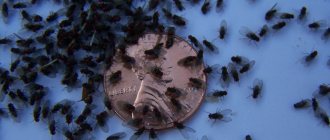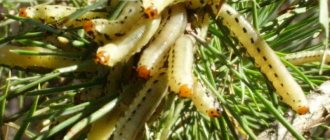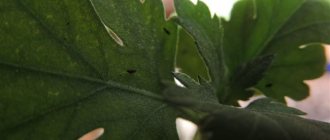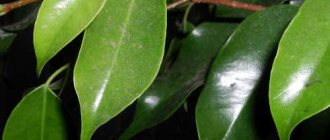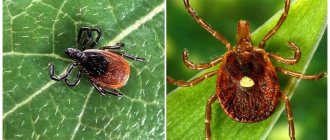What do mites look like on orchids?
Small pests with an elliptical, oval-shaped body, with 4 pairs of legs. Length – 0.1-1.1 mm. Color depends on the type (whitish, black, brick, yellowish). Inconspicuous, they prefer to settle on the lower part of leaf blades, laying eggs along the way. If you do not pay attention to the flower, the population grows to catastrophic proportions.
External signs of infection:
- small depressed gray blotches on the green part of the leaves;
- deformation, drying of the plates along the edges, characteristic silvery coating;
- thin-leaved - curl into a tube, turn yellow, fall off;
- rotten areas at the base of the plant;
- unusually short peduncles, brown spots on deformed flowers;
- web.
Biological characteristics
Ticks are part of the arachnid family, numbering more than 54 thousand species. They have microscopic dimensions and settle mainly in the upper soil layers, rich in decomposing organic matter.
General description:
- the body is solid or consists of divided parts with a border closer to the front, length 0.2-0.4 mm;
- there is a protective cover in the form of a chitinous shell or a hard shield;
- usually 6 pairs of legs, 4 of which are hind legs with claws and stalked suckers, a pair of anterior claw-shaped chelicerae, forming a piercing-cutting oral structure, a pair of pedipalps (legs) included in the structure of the oral organ.
Varieties
Most mites are free-living, non-parasitic saprophages that feed on decaying organic matter. However, there are varieties that parasitize vegetation, pose a veterinary hazard to animals and transmit diseases to humans.
The following appear on orchids:
- armored - prefers to settle in the soil, feeding on rotting parts of plants;
- false, or white cobweb - entangles the vegetative mass of the orchid with a thin white web;
- flat-bodied - the body is oval, flattened, bristly, yellow-red in color;
- root - has increased endurance, maintaining viability without nutrition for a long time, feeds on organic residues and underground plant parts, very dangerous for orchids, because often invisible;
- red spider - considered the most dangerous, because is immune to the effects of chemical agents, color - in shades of yellow-red;
- bulbous - settles mainly on pseudobulbs, brown in color;
- phalaenopsis - most often affects phalaenopsis in shaded places (leaf axils, near the base of peduncles, at the roots), but is able to reproduce on other orchid varieties, the color is red;
- greenhouse - looks like phalaenopsis, but differs from the latter in its flat-bodied structure with a terracotta base color and a mesh pattern.
Which parts of the flower are affected?
Depending on the family, mites settle in the substrate, on leaf blades, or at the growing point. Active life activity harms green mass, buds, peduncles, flowers, and roots.
Types of damage:
- in places of bites, the leaves lose juice along with chlorophyll cells. The damage gradually spreads to the entire flower, the plates acquire a marbled coating, turn brown, and finally dry out;
- living in the substrate, damage the root system. Feeding on plant tissue, large colonies turn roots into dust.
Peculiarity! A pest is a carrier of bacteria, fungi, and viruses. Along with damage from their vital activity, infectious lesions develop. The first sign is wet spots on the foliage.
Fighting methods
If you manage to detect a spider pest, it is recommended to separate the infected flower from other plants so that the mites do not move to new territories. Of course, you will need to increase the humidity, which these individuals do not like so much. This will help stop their reproduction.
You will need to wipe the leaf plates; such actions will help remove individuals that have not attached themselves to the plant. To do this, use alcohol, which is moistened with a cotton swab. But if the plant is young or has thin-skinned leaves, then alcohol should be avoided, as it can cause burns.
You can move on to exterminating pests, but to do this you need to choose the most suitable method. When the orchid is not heavily infected, traditional methods will be effective, but when the infection is severe, it will be necessary to use chemicals.
Traditional methods
In this case, infusions and decoctions from plants that have an insecticidal effect are used; they are absolutely safe for orchids:
- Cyclamen tubers. They must be divided into parts, filled with water and put on fire. This decoction is boiled for 40 minutes, after which it is left for a day. Next, strain, pour into a spray bottle and treat the orchid every 5 days.
- Onion. You can use onions, which require 15 g, or husks, which need 6 g. The product is placed in a container, filled with 1 liter of water and infused for 6-7 hours.
- Dandelion roots. They can be purchased at a pharmacy, you will need 20-30 g, add 1 liter of water and leave for several hours.
- Garlic. You need to take 170g of the product, grind it very finely to a paste, add 1 liter of water and leave for 5 days. You need to insist in a closed and dark container. Next, the infusion must be diluted, adhere to the following dosages, per 1 liter. water 6 g infusion. Treat every 5 days.
There is another very simple, but at the same time effective method. An experienced owner of an orchid collection advised putting garlic cloves directly into the substrate for the flowers. As practice has shown, the method is really effective.
As we know, mites carry a variety of bacteria and microbes through the affected areas on the leaves; they quickly penetrate the plant tissue, which causes a variety of diseases. If there are cuts or breaks on the leaf plate, they can be treated with colloidal sulfur; crushed birch charcoal is also quite effective.
Chemicals
If we consider that the orchid is kept at home, then its processing certainly requires the use of gentle means so as not to cause harm to humans. The most commonly used drugs are Fitoverm, Actelik, Vermitek Actofit, which are classified as avermectins. But their use will not ensure the destruction of eggs and larvae, so a repeat procedure is required, which is carried out after 9-10 days.
Remember about temperature, which affects development, this time interval is observed at a temperature of 20-25°C, at a temperature of 30°C we reduce the interval to 3-4 days. When processing, it is necessary to apply the product not only to the flower itself, but also to the substrate, window sill, and stand.
It should also be said that ticks quickly develop immunity to the active substances of chemicals, therefore, in order for treatments to bring a good result, it is necessary to change the preparations.
To destroy the flat beetle, such means as Acrex, Fozalon, Tsimbus, and Ambush are also used. But the fight against phalaenopsis mites becomes much more complicated, for the reason that they live in places where processing agents do not reach. In addition, they lay eggs in the root part.
Also remember that this species cannot be affected by drugs that have an intestinal-contact effect. Unfortunately, it is impossible to destroy them using means that are safe for humans and can be used at home.
Sometimes the fight against these pests drags on for a very long time; it takes a lot of effort and patience to achieve the desired result. Some take drastic measures and use potent carbamate chemicals, which can quickly get rid of ticks.
For example, Marshall, which is a systemic acaricide. The action is carried out thanks to the rather toxic substance carbosulfan. Remember that its use is allowed only in non-residential premises subject to all safety measures. It is produced only in liquid form; commercially available powders under this name are fake.
Why is Phalaenopsis dangerous?
Ticks love the fleshy leaves of Phalaenopsis. They bite the juicy flesh, injecting a toxic substance into the cells.
Then the following happens:
- toxins dissolve the membranes, the orchid secretes juice;
- The mite sucks out the juice and air gets inside the cells. The green mass turns white;
- Over time, the leaves turn yellow and fall off, and the Phalaenopsis dies.
Peculiarity! If a flower is attacked by an oribatid mite, the deformation begins from the topmost leaf. The cover becomes thinner, corrugated edges appear. On adult specimens, the edges of the flowers are eaten away and dark spots form on them. The damaged plant dies.
Causes of the pest
A mite can also appear on a healthy orchid, but most often this is facilitated by certain factors:
- Insufficient or infrequent watering . Ticks love low air humidity and dried substrate.
- Frequent fertilizing (when the soil is oversaturated with minerals and other beneficial substances).
You can “purchase” a mite by purchasing ready-made soil or a new orchid specimen at a flower shop. Sometimes the parasite enters with a gust of wind through an open window, and then moves into a pot with a plant. The arthropod pest can also be brought home on clothing.
Description of types of ticks with photos
The pest belongs to the class of arachnids and has more than a hundred families and 50 thousand species. Only some of them attack indoor plants.
Arachnoid
Changes color depending on the food consumed. As a rule, it takes on a red or green color.
Description:
- abdomen oval, 0.3-0.5 mm;
- loves warmth and dryness. Young individuals develop poorly in high humidity;
- lives in a thin web, multiplies quickly, giving dozens of new generations;
- the moment of maturity occurs 10-20 days after laying eggs. Larvae have 3 pairs of legs;
- life cycle – no more than 4-5 weeks.
White
A representative of the group of spider mites. The body is oval, elongated, sharply tapering towards the posterior end. Size – 0.25-0.43 mm. Lays greenish glassy, spherical eggs. It feeds on the underside of leaves; in places where it is pricked, the tissues become discolored and die.
Red
Very small, about 0.25 mm, inactive, oval, with a red belly, head, and paws.
There are two types:
- Tenuipaltis pacificus – orchidaceous;
- Brevipalpus obovatus – greenhouse mite.
It does not weave a web, so it is difficult to notice. The mite slowly spreads throughout the flower, so visible lesions are a sign of a huge population. Lives on the inside of the plates. Calmly survives high humidity.
Armored
The Oribatidae group of ticks is diverse and contains more than 6 thousand representatives. House plants are attacked by small black insects, 0.2-1.4 mm in size. They live in the substrate - often based on bark, feeding on plant debris and moss. Less common in blocks. They prefer vanda, phalaenopsis, paphiopedilum. Harm comes from catastrophically large colonies.
Bulbous
A large insect with a thickened oval body and two pairs of legs. The color is whitish, cloudy, glassy. Body length – up to 1.1 mm and more. During its life, it lays white, oval eggs. Prefers overfed, abundantly moistened substrate. Turns roots into dust, causing the death of the orchid.
Root
Broadly oval, light yellow, with glossy, smooth skin. The legs are short, thick, with large spines. Length – 0.78-1 mm. Females lay oval white eggs. It feeds on plant tissues of the root system. Very moisture-loving. It quickly thins the roots, turning them into dust. Leaves and flower stalks are damaged. Carrier of fungi and bacteria. If measures are not taken, the orchid will die.
Mealybug - traditional methods of treatment
- Horsetail tincture. For mealybugs, you can water and spray diseased plants with horsetail tincture. Horsetail is sold in pharmacies and is used as a diuretic, blood purifier, etc. The German name is Schachtelhalmtee. You need to brew the composition according to the instructions on the package, let the preparation cool and carefully generously spray all the leaves and trunks of infected plants, spraying the leaves both above and below.
- Oil spray for spraying. 1 liter of water is mixed with 2 tablespoons of olive oil, and then the emulsion is applied to the plant (best by spraying), it is believed that the oil does not allow adult mealybugs to breathe and they should suffocate. However, this remedy will not affect pest eggs, since they are in a dense shell.
- Alcohol solution with soap. Treating the mealybug plant with a mixture of 3 tablespoons of liquid soap, 10 ml of denatured alcohol (Brennspiritus) and 1 liter of warm water can also be successful. Mix the mixture thoroughly and spray on diseased plants.
- Garlic tincture. Take 4-5 cloves of garlic per 0.5 liters of water. The water must be brought to a boil, and the garlic must be finely chopped or squeezed. Then pour boiling water over the garlic and leave for 3-4 hours. We filter the infusion through cheesecloth and apply it undiluted with a brush to the leaves affected by mealybugs, if your plants are small, or by spraying.
How effective are folk remedies for treating mealybugs?
Mealybug - methods of traditional treatment for it have the advantage only that they do not have a strong odor, which is from chemical preparations, this is their undoubted advantage.
But, as the modern practice of floristic maintenance of plants shows, in organizations and offices it is inappropriate to use traditional methods - insufficient efficiency, not 100% death of eggs, larvae and adult mealybug insects. Multiple treatments will also be required. Therefore, it is more effective in plant care companies to use modern chemicals. This is clear.
The best advice is that if you have mealybug found on your plants, in order not to lose them completely, we recommend turning to professionals to treat the plants. Florists have their own professional products, and we also prepare special mixtures - chatterboxes, which are not sold in flower shops.
Do you have any questions? Do mealybugs eat plants? Call our florists!
Spider mitePhytopathologist
| DO YOU WANT TO CALL A SPECIALIST TO TREAT FLOWERS? Contact us at: +7(WhatsApp) |
What to do?
The fight against spider pests begins with thoroughly washing the outer part of the orchid. The plant is carefully and carefully wiped. Take a solution based on laundry soap or dishwashing detergent. Do not allow liquid to get on the roots. The substrate will move towards the alkaline side and damage the flower.
Armored ones live in the substrate, here the procedure is different:
- Remove the flower from the pot.
- If possible, completely remove old bark.
- Soak the root in warm water for 30-40 minutes. The tick will get into the air capsule and float up over time. Periodically stir the plant in the water to shake off the balls.
- Mites have appeared on the water, remove the flower and drain the liquid.
- Repeat 2-3 times. Make sure all bugs are washed away.
- Plant in new substrate.
Important! Remove damaged peduncles and leaves. Disinfect the cut areas with cinnamon or activated carbon. Treat with traditional methods or an insecticide.
How to fight with folk remedies?
If your orchid is infested with spider mites, hide it in a sealed plastic bag. Flush well first. Leave for 3-4 days in a shaded area, otherwise the flower may wither. A microclimate with high humidity is formed inside. Thus, the bulk of the population will die before the chemicals are applied.
Recipes:
- cyclamen - use a decoction of tubers. Divide into parts, boil in boiling water for 40 minutes. Cool, leave to infuse for 24 hours, filter. Treat the leaves with a spray bottle and repeat after 5 days;
- rubbing alcohol – works on varieties with tough leaves, such as cattleya. Test on a small area. Wipe the plates with a slightly moistened cotton pad. Make sure that the liquid is applied in a thin layer. This way it will evaporate quickly and will not cause burns.
How to get rid of it with drugs?
A group of drugs aimed at eliminating ticks is called acaricides. Read the instructions to properly dilute the solution. Wear gloves.
Important! You cannot completely rely on the effectiveness of chemicals, since ticks quickly develop immunity. The solution is to purchase two concentrates with different active ingredients.
Types of acaricides:
- contact - pyrethroids penetrate the skin of the pest;
- intestinal – enter through the mouth;
- systemic - absorbed by plates, orchid roots. The juice becomes poisonous.
Spraying is carried out during the growing season. Use ready-made solutions in the form of sprays. Treat all green mass and soil. Spray twice, repeating the procedure after 14 days.
If you choose concentrate:
- dilute the drug according to the instructions in a bowl of water;
- cover the substrate with film;
- dip the green mass of the flower into the solution, wetting each part - growing points, rosettes, axils;
- carry out additional treatment with a fungicide if the orchid has become infected with fungus.
Table No. 1. Acaricides for orchids
| Name | Active substance | Processing type | Working solution | Efficiency |
| Vertimek | Abamectin | Spraying, the plant is placed in a bag, removed after a day | 18 g/l | +++ |
| NimAtzal 1% | Azadirakhtin | Wipe both sides of the sheets with the working solution. 1-3 treatments are required with an interval of 5-7 days | 7.5 ml/1.5 l | ++ |
| Apollo | Clofentesine | Spraying green mass | 2 ml/5l | +++ |
| BI-58 | Dimethoate | Spraying | 4g/l | ++ |
| Dimethane-SK | Phenazakhin | Spraying | 2g/l | +++ |
| Masai | Tebufenpyrad | Soaking green mass | 5 g/l | ++ |
Prevention of infection
Spider mites infect orchids quite often. For planting, you need to use only a tested and disinfected substrate. When purchasing new plants, they must be quarantined for 2 weeks in a separate room.
It is important to do:
- regular inspection of the flower;
- wiping the stems and leaves with a disinfectant;
- watering, for which use warm water, which helps wash off the parasite larvae and adults;
- regular inspection of the soil to prevent waterlogging or drying out;
- timely removal of water droplets that remain inside the inflorescences after spraying;
- humidification of the room, since dry air promotes the active reproduction of pests;
- regular spraying.
You may be interested in:
What to do if all the leaves of an orchid have fallen off Amazing orchid flowers decorate interiors with their delicacy and variety of color combinations. There are more than 30…Read more…
Spider mites on an orchid are a serious problem, and if it occurs, you need to immediately begin fighting it to prevent the death of the flower. Many techniques have been developed to help in this situation, but the choice of method must be done very carefully so as not to aggravate the condition of the plant.
Preventive measures
Newly purchased orchids need inspection. Arm yourself with a magnifying glass and check them for ticks and eggs. Wipe the leaves with a damp cloth - this will make it easier to detect small punctures.
Prevention:
- Give the plant a hot shower periodically. This will partially kill the eggs and help you quickly recognize the web, if there is one. The water temperature should be such that the delicate skin on the bend of the arm can withstand it.
- Treat all plants that were in the same room as the infected orchid. Wash the window sills and shelves on which the pots stand. Scald the containers with boiling water.
- Provide the correct microclimate, do not allow waterlogging or excess substrate.
- Remove old leaves in a timely manner and inspect the flower for damage.
Rate this post
Signs of defeat
The mite feeds by sucking juices from plant cells, which first leads to the appearance of small spots, and then to depigmentation of the entire leaf. It is easy to determine whether a plant is affected by this pest - just take a close look at the leaves and flowers, paying attention to:
- the presence of a small cobweb on the back of the leaf, as well as on the flowers;
- brownish dots located all over the surface of the leaves, and the tips are curled and withered;
- small dots (these are the mites themselves) moving along the surface of the plant or along the web.

